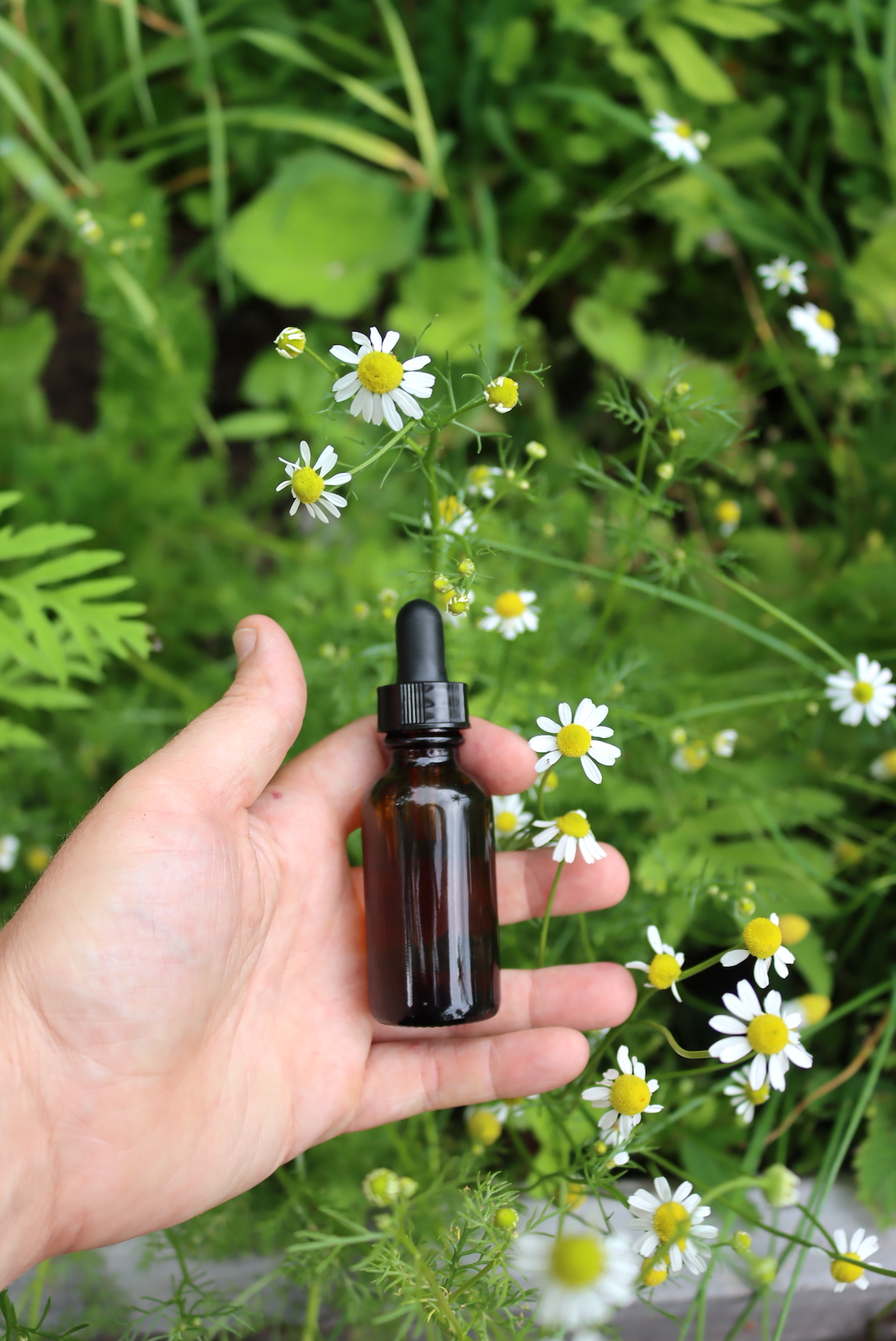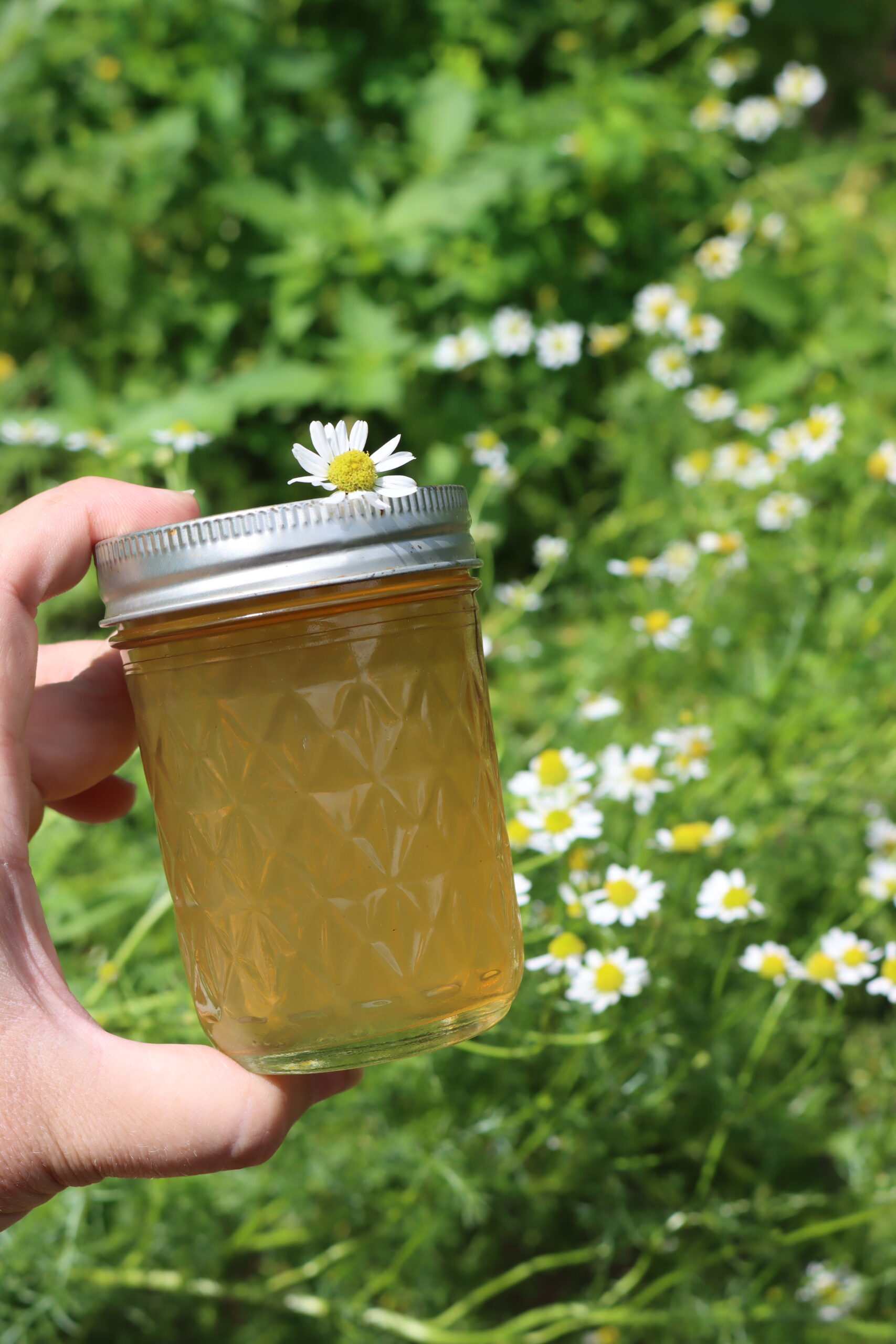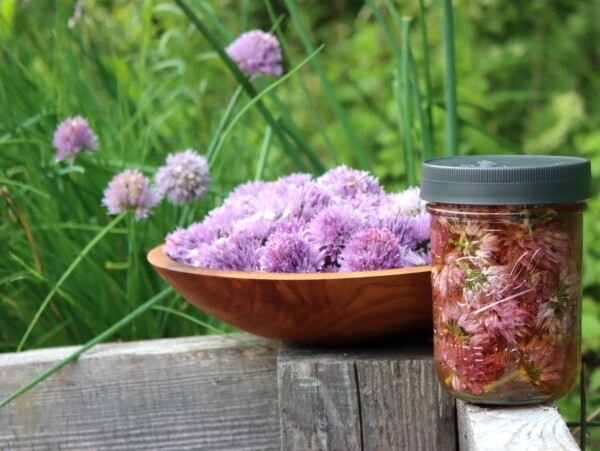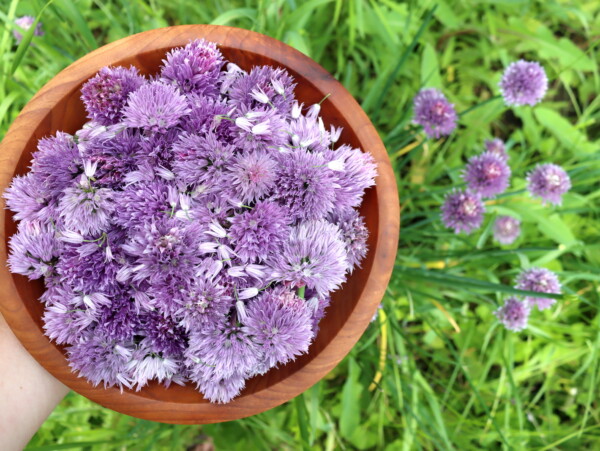This post may contain affiliate links. Please see our disclosure policy.
Chamomile flowers are edible and delicious, and they can be made into a lot more than just tea!

Chamomile flowers are delightful to behold lining gardens and rock walls, but this flower is also a versatile ingredient that can be infused into much more than tea.
Chamomile blooms in both the spring and summer with the main picking season between June and September. Chamomile loves sunny locations and partial shade and grows well in USDA zones 4 to 8, with some varieties spanning as far as zones 2 to 9.
There are actually about 25 species in the chamomile genus Matricaria, but the type most popularly used in culinary applications is German chamomile. This plant, native to Europe, India and China, produces daisy-like flowers with white petals and yellow centers throughout their long bloom season in summer.
German chamomile is actually an annual plant, yet plants often reemerge each year when the plant self-seeds, leading many to think the plant is perennial. Roman chamomile, however, is perennial and is surprisingly from a different plant genus (Chamaemelum) – although it is nearly identical to German chamomile in many ways.

Choosing the Best Chamomile
Be wary of gathering chamomile in the wild – there are chamomile look-alikes which are toxic such as Anthemis cotula, known sometimes as Stinking Chamomile. This plant, however, lacks the welcoming scent of chamomile, hence its name. There is also Anthemis tinctoria, called Dyer’s chamomile as it is used to create dyes, not teas. This plant lacks the white petals of traditional chamomile though, instead being entirely yellow.
The two most popular types of chamomile to select for culinary use are German chamomile (Matricaria chamomilla) and Roman chamomile (Chamaemelum nobile), also called English Chamomile. That said, Roman chamomile is less popular in teas due to its somewhat more bitter taste.
German chamomile is taller while Roman chamomile is more of a creeping plant. There is also pineapple weed (Matricaria discoidea) sometimes called wild chamomile, which has yellow-green flower heads without petals. This variety is also edible, tasting sweet with a pineapple and mellow chamomile tea flavor.
Still, it is best to grow chamomile from seed, collect from friends’ and neighbors’ gardens, or order from a reliable source so you can be sure the plant you are sourcing is indeed chamomile in addition to being pesticide and chemical-free.
Chamomile should be harvested on a sunny day, close to the middle of the day when flowers are most open. Pick flowers that are in full bloom – this occurs about 3 to 5 days from when the flower bud begins to open. These are reported to have the most flavor and highest essential oil content.
For best results, cut blossoms just below the flowerhead at the start of the stem on the same day you plan to use or preserve.
Chamomile Recipes
Chamomile flowers harbor a mild, softly-sweet flavor with earthy undertones. Some find the flavor of German chamomile flowers to be less bitter than Roman chamomile, but this varies by personal taste.
You can use chamomile flowers as a garnish or infuse the flowers into other ingredients to be used in cooking like tea, sugar, milk, wine or oil.
Many of these recipes call for using bags of chamomile tea but, of course, you can use your own fresh or dried flowers to make chamomile tea.
A cup of chamomile tea is usually made from 1-2 tablespoons of dried chamomile, but when using fresh flowers the amount is generally 3 to 4 tablespoons. So the general rule of thumb is to use 1-2 tablespoons of dried flowers for every tea bag or 3 to 4 tablespoons fresh when substituting your own chamomile for tea bags in these recipes.
Fresh Chamomile Recipes
Fresh chamomile flowers are a wonderful complement to salads and other dishes. Use chamomile flowers along with other edible blossoms like violas, pansies, wild radish blossoms and calendula petals mixed with fresh greens for an edible flower salad. Radishes and peas are another complement to this fresh summer flower. Simply use whole blossoms in your favorite assortment of greens and veggies or create a dressing brewed from chamomile tea to top your favorite salad.
To substitute fresh flowers for dried in recipes calling for chamomile tea, simply double the dried amount. Consider adding this freshly brewed chamomile tea to soup recipes like vegetarian chamomile corn chowder, carrot soup or cauliflower soup for a soothing nighttime meal. Top with fresh blossoms if desired.
Fruit salad can also be topped with pretty chamomile flowers and tea can be used to make a sweet syrup for tossing sliced strawberries, melons and stone fruits. Fresh flowers also make a lovely edible garnish for baked goods like honey chamomile cake or a berry-filled Dutch baby. Still have fresh flowers to spend? Try chamomile rice pudding, make a chamomile gelato with fresh blossoms, heavy cream and carob powder, or simply try sweet chamomile cookies.
Savory
- Edible Flower Salad
- Asparagus, Pea and Chamomile Salad with Baked Ricotta
- Herb Salad with Lemon Ginger Chamomile Dressing
- Chamomile Olive Oil Dressing
- Carrot Chamomile Soup
- Chamomile Cauliflower Soup
Sweet
- Strawberry Fruit Salad With Chamomile Syrup
- Chamomile Stone Fruit Salad
- Garden Fresh Berry & Chamomile Dutch Baby
- Chamomile Rice Pudding with Tea-Infused Golden Raisins
- Chamomile Gelato
- Chamomile Cookies
Chamomile Breakfast Recipes
Adding chamomile to breakfast recipes might seem contrary, but it can actually be a very relaxing start to your day. Mix fresh or dried flowers directly into porridge sweetened with maple syrup or oatmeal topped with banana slices and coconut flakes. Use chamomile flowers or chamomile tea to make a honey chamomile syrup to top pancakes and waffles or stir into yogurt.
French toast is a spectacular treat made by infusing heavy cream with chamomile tea while chamomile poppy seed bread can be made by brewing a concentrated chamomile tea to add to batter. Just half a cup of dried chamomile can be used to make paleo-friendly chamomile muffins. And for those not a fan of gluten-free recipes, there are also lemon blackberry muffins made by grinding dried chamomile and blending into a chamomile-infused sugar.
- Chamomile and Maple Porridge
- Chamomile Quinoa Porridge with Banana Brûlée
- Honey-Chamomile Syrup
- Chamomile French Toast
- Chamomile Lemon Poppy Seed Breakfast Bread
- Chamomile Muffins (gluten-free)
- Lemon Blackberry Chamomile Muffins
Chamomile Savory Main Courses
Decrease dinnertime stress by adding chamomile flowers to evening meals. Roast chicken in a white wine and chamomile infusion for a succulent supper. Serve with chamomile tea rice to complete the meal or try chamomile potatoes. For lovers of seafood, chamomile can also be used to cure salmon in a gravlax or poach scallops.
For vegetarian-minded meals, consider using chamomile flowers to make a lemon cream sauce for ravioli and other light pasta dishes. Toss with angel hair or spaghettini and top with lighter veggies like zucchini, peas or artichokes. Grate parmesan for extra cheesy goodness.
- Chamomile Roast Chicken with Leeks and Onions
- Chamomile Infused Jasmine Rice with Broiled Salmon and Asparagus
- Chamomile-Pickled New Potatoes with Beurre Blanc
- Chamomile Gravlax with Potato Waldorf Salad
- Scallops Poached in Chamomile Tea
- Chamomile Lemon Cream Ravioli
- Chamomile, Saffron and Squash Spaghettini (vegan)
Chamomile Drink Recipes
Chamomile flowers make a great addition to beverages of all types. Ice cream, chilled sparkling soda, chamomile buds, sugar and water are all you need to make a cooling ice cream float. Chamomile moon milk is a warming treat in the evening. For hot summer days, try out chamomile lemonade or make a lemon peel syrup from flowers to add to cocktails and mocktails.
Several adult beverages can be using chamomile blossoms, whether fresh or dried. Try a lemon balm and chamomile cordial to add to sparkling water or mix chamomile tea with whiskey and honey syrup. Gin fizzes, bee’s knees and gin sours are other options.
And the subject of tea, know there are several recipes for making chamomile tea from fresh flowers. Some involve the addition of mint, orange zest or lavender. Add milk honey and cinnamon to make it a latte.
- Wild Chamomile Ice Cream Float
- Chamomile Moon Milk
- Chamomile Lemonade Recipe
- Chamomile and Lemon Peel Syrup
Cocktails and Cordials
- Chamomile and Lemon Balm Cordial
- Honey Chamomile Whiskey Cocktail
- Chamomile Gin Fizz
- Chamomile Bee’s Knees Cocktail
- Chamomile Sour
Teas
- Chamomile Tea with Fresh Flowers and Mint
- Fresh Chamomile and Orange Tea
- Lavender-Chamomile Herbal Tea
- Chamomile Latte
Chamomile Snack Recipes
For snackable appetizers including chamomile flowers, try a chamomile hummus to serve with crackers or toasted pita. A chicken salad can be made by implementing chamomile into a creamy dressing. Dried blossoms can be used to make chamomile tea cookies while fresh blossoms and raw honey lead to cooling chamomile popsicles.
You can also make sleep-inducing gummies from chamomile tea – all you need is chamomile, gelatine, honey and water. There are even calming chamomile gummy dog treats made from powdered gelatin and unseasoned stock. Now Fido can relax too!
- Chamomile Hummus
- Chicken Pasta Salad With Creamy Chamomile Dressing
- Chamomile Tea Shortbread Cookies
- Honey Chamomile Popsicles
- Chamomile Sleep Gummies
Chamomile Dessert Recipes
Feel free to add chamomile blossoms to your next dessert recipe by garnishing with fresh blossoms or infusing the flavor right into your dessert. Honey buttercream cake can be made by infusing chamomile into butter, while honey panna cotta simply requires adding tea to batter and glaze. Layers of thin chamomile crepes and honey-mascarpone yield a stunning layered crepe cake you can garnish with fresh flowers. Chamomile cupcakes made from flower-infused milk are another treat that is sure to delight.
Use dried chamomile flowers for panna cotta and pudding, straining the flowers from the mixture to ensure a smooth texture. Chamomile ice cream will round everything off. Use honey and buttercream for a classic recipe, or go dairy-free and try coconut milk and coconut cream with salted caramel.
- Chamomile Cake with Salted Honey Buttercream
- Chamomile Pound Cake
- Honey Chamomile Crêpe Cake
- Chamomile and Honey Cupcakes
- Honey Chamomile Panna Cotta
- Chamomile Pudding With Stewed Rhubarb
- Honeyed Buttermilk and Chamomile Ice Cream
- Vegan Salted Caramel & Chamomile Ice Cream
Preserving Chamomile
It sounds like something you’d never say, but sometimes you’ve just got too many flowers. In cases where you’re overloaded with chamomile blossoms and don’t want your flowery bounty to go to waste, your best bet is to preserve the overflow for future use.
Although fresh flowers can be kept in the refrigerator for a few days, if you’re keeping chamomile blossoms any longer you’ll want to dry them. You can use a dehydrator, oven or simply air dry chamomile by placing freshly harvested blossoms on a flat surface for a few days to dry. Once completely devoid of moisture, they should be stored in a glass jar in a cool, dark and dry location.
Some also freeze chamomile by wrapping flower heads in aluminum foil and storing in the freezer for up to 6 months. A chamomile tincture is another option, helpful for alleviating insomnia and anxiety.
There are, of course, a few other preservation options to continue the flavors of chamomile throughout the year. These include making flower-infused sugar or adding chamomile to jams and jellies. Chamomile makes a lovely flower jelly on its own, but it can also be added to other preserves like apricot or blueberry jam, or herbal and fruit jellies.

Jams and Jellies
- Rose Petal, Chamomile, and Lavender Jelly
- Tuscan Chamomile Lemon Jelly
- Apricot Chamomile Jam
- Blueberry Jam with Chamomile

Cultured & Fermented Chamomile
Looking to include chamomile flowers in your next fermented recipe? There are plenty of options to do so! Spice up your next mead recipe with the addition of chamomile and vanilla or drop some flowers into an ale recipe. You can also try lacto-fermented tea, kefir soda and kombucha with chamomile flowers.
For fermented food items, test out chamomile pickled baby potatoes. There’s also an included recipe to make a chamomile potato salad with a seaweed butter sauce. You can add chamomile flowers to other pickling solutions for a floral tone as well. Consider chamomile pickled carrots to start – the somewhat sweet-tart result pairs well with cheese plates and hummus boards.
- Chamomile Vanilla Mead
- Chamomile Ale (Beer)
- Lacto-Fermented Herbal Tea Drink
- Chamomile Lemonade Water Kefir Soda
- Chamomile Kombucha
- Quick Chamomile Pickled Potatoes
- Chamomile Pickled Carrots
Edible Flower Recipes
Looking for more edible flower recipes?





1 Comment